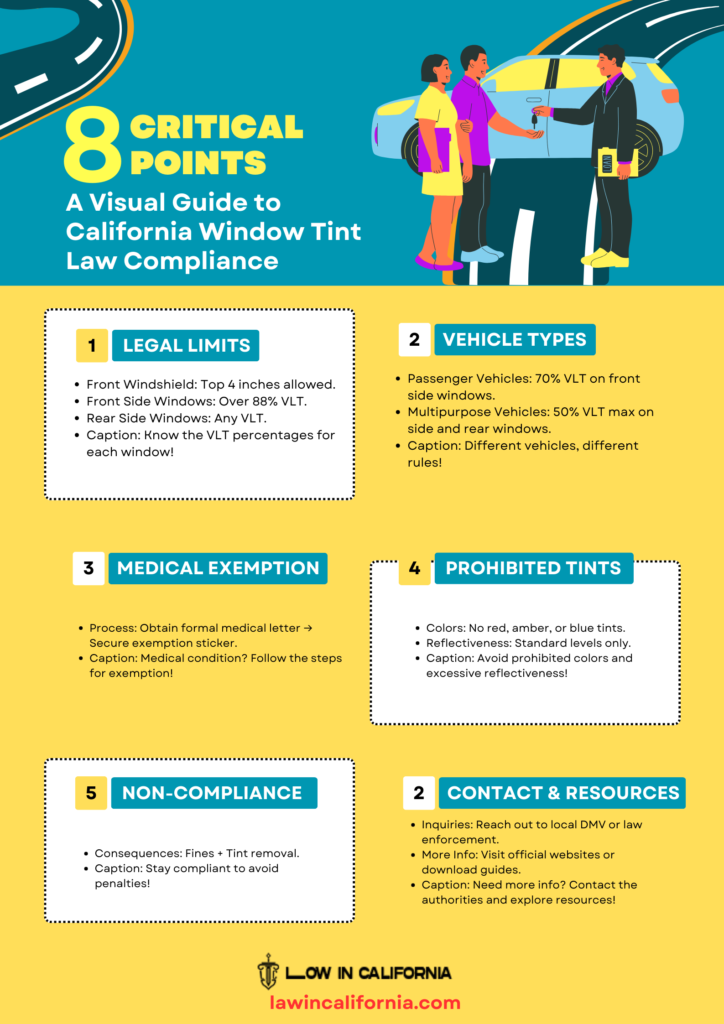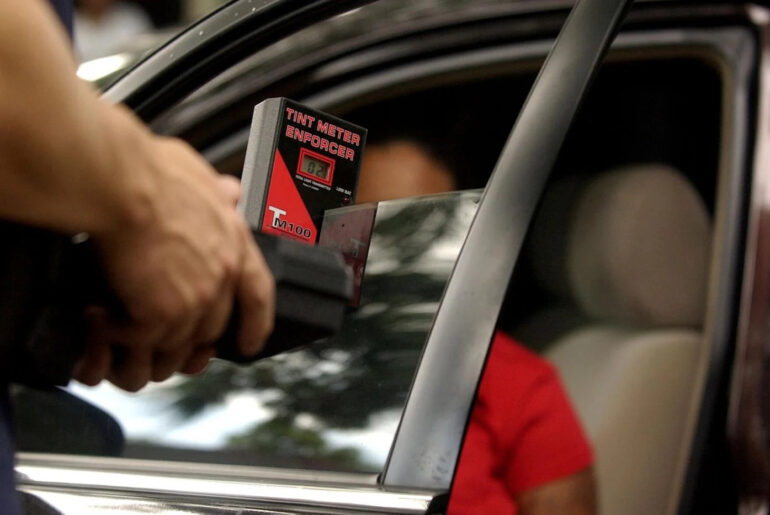california window tint law
California window tinting laws are in place to ensure that drivers have the necessary visibility while on the road. The darkness and reflection of car windows must meet certain standards set by the state, which were enacted in 1999. These laws are designed to protect drivers from potential hazards caused by reduced visibility due to tinted windows. Additionally, they can also help protect privacy for those who choose to tint their windows.
Window tinting has become increasingly popular over the years, as it increases visibility and provides a layer of privacy for drivers. However, it is important to note that these regulations are subject to legislative action and may change over time. It is important for drivers to stay up-to-date on any changes in California window tinting laws so they can remain compliant with the law when driving. By following these laws, drivers can ensure that they remain safe and legal while on the road.
Get the lowdown on California’s window tinting laws. Learn how to apply, what the rules are, and other important information you need to stay within legal limits.
The Legal Amount Of Window Tint In California
Window tinting is a popular way to customize a vehicle and provide privacy, but it is important to be aware of the legal amount of window tint in California. According to state law, all windows may be tinted, but the front windshield must have only four inches of tint. Stickers or other visual obstructions are prohibited on front-facing windows. Improperly installed window tint that bubbles or deforms with age can create a visual obstruction for the driver and result in a traffic stop.
The percentage of allowable visible light transmission (VLT) varies depending on the window’s location on the vehicle. Front windshields are only allowed to have the top four inches tinted, while front side windows must have at least 88% VLT and rear side windows can be tinted with any VLT. It is important to adhere to these regulations when applying window tint as failure to do so could result in fines or other penalties. Additionally, it is important to ensure that any window tint ing is done professionally to ensure that it meets the standards set by the state.
How to apply window tint in California law

Purchase window tint that meets the legal requirements in California. The law allows for a front windshield tint with a maximum of 70% light transmission. The front side windows can have a tint with a maximum of 50% light transmission and the rear window can have 35% light transmission.
Measure the window correctly. Measure the edges of the window with the tape measure to ensure that the tint is cut to the correct size.
Cut the tint to size. Use a pair of scissors or a razor blade to cut the window tint to the correct size. Make sure to cut it slightly larger than the window to allow for extra material to adhere to the edges.
Clean the window. Use a glass cleaner and a clean cloth to clean the window thoroughly to ensure that the tint will adhere properly.
Apply the tint. Spray the window with a window tint solution and then carefully place the tint on the window. Use a squeegee to push out any air bubbles and to ensure that the tint adheres properly to the glass.
Trim the edges. Use a razor blade to trim the edges of the tint to ensure that the window looks neat and tidy.
Is There A Medical Exemption From California Window Tint Law?
California window tint laws passed in 2022 may allow for a medical exemption for those who need it. To apply for the exemption, a formal letter from a primary care provider must be obtained. This letter must state that dark window tint is medically necessary. Once this note is obtained, it can be taken to the local motor vehicle office and an exemption sticker will be issued to put on the car. Starting in 2022, drivers who need the exemption may be required to install transparent and colorless treatments instead of traditional tinted windows.
The medical exemption from California window tint law is beneficial for those who require darker windows due to medical reasons such as sensitivity to light or other health issues. It allows them to drive safely while still protecting their eyesight and overall health. The process of obtaining an exemption sticker is relatively simple and straightforward, making it easier for those with medical conditions to get the protection they need while driving.
What Happens If I Violate California Window Tint Law?
California window tint laws are in place to ensure the safety of drivers and passengers on the road. Non-compliance with these laws can result in a traffic stop and potential fines. It is important to be aware of both state and local regulations when it comes to window tinting, as they may vary from county to county. The law applies to all vehicle types, including cars, trucks, SUVs, vans, and buses.
The California Department Of Motor Vehicles (DMV) provides detailed information on requirements for window tinting. For example, front windshields can only be tinted in the top four inches while aftermarket front side windows must have a VLT (visible light transmission) of over 88%. Factory-installed front side windows and rear side windows can have any tint that meets the minimum VLT requirement. If you are unsure about your vehicle’s window tinting requirements or would like more information on options available, contact your nearest DMV office for assistance.
Legal Limits on Window Tinting in California
In California, the legal limits on window tinting depend on the type of vehicle. Passenger vehicles and multipurpose vehicles must have a minimum of 70% light transmittance on the windshield and the front side windows. The rear windows can have a minimum of any darkness. For all other vehicles, the windshield must have a minimum of 70% light transmittance, but the side and rear windows can have a maximum of 50% light transmittance. It is important to note that California window tint laws are subject to change, so it is important to stay up-to-date with the latest regulations. Additionally, local law enforcement may have their own rules and regulations regarding window tinting, so be sure to check with your local police department before making any changes to your vehicle.
Other California Window Tint law Rules And Regulations:
California window tint laws are in place to ensure the safety of drivers and passengers on the road. The laws were enacted in 1999 and require that vehicle owners double-check with local DMV or law enforcement agencies for accuracy. Vehicle owners may file for a medical exemption if a licensed physician determines it is necessary due to diseases or disorders. Dual side mirrors are required if the rear window is tinted, and red, amber or blue tint colors are not permitted on side windows. Certificates and stickers from the installing company and manufacturer must be in possession for all tinted windows. Medical exemptions may apply for lower tint on all windows.
It is important to adhere to California’s window tint laws as they are designed to protect everyone’s safety while driving. Violations can result in fines and other penalties, so it is important to understand the regulations before applying any type of tinting material to your vehicle’s windows. If you have any questions about what type of tinting is allowed in your area, contact your local DMV or law enforcement agency for more information.
For Safety and Appeal, Follow State Window Tint Law
Window tinting can be a great way to add appeal and benefits to your vehicle. Not only does it give your car a sleek look, but it also helps protect you from the sun’s harmful UV rays. However, window tinting laws vary from state to state, with some states not allowing any window tint at all. It is important to familiarize yourself with the laws in your state before having your windows tinted.
In California, window tint laws regulate the percentage of visible light that can pass through a vehicle’s windows, known as Visible Light Transmission (VLT). The allowable VLT varies depending on the window’s location on the vehicle. For example, front windshields are only allowed to have the top four inches tinted, while front-side windows must be over 88% VLT for aftermarket film and 70% VLT for factory-tinted windows. Following these regulations will ensure that you stay safe and legal when it comes to window tint ing.
It is also important to note that California window tint laws require dual side mirrors if the rear window is tinted, and red, amber or blue tint colors are not permitted on side windows. Certificates and stickers from the installing company and manufacturer must be in possession for all tinted windows. Medical
Benefits of Window Tinting
Window tinting is a great way to customize the look of your car and increase its privacy. It also has several practical benefits, such as keeping the interior of your car cool and protecting upholstery from UV rays. Window tinting can be done in three ways: glass tinted during manufacture, spray-on coating, or film coating applied to the window interior. Most shops use film coating to darken car windows, while tinted glass is usually only available directly from the manufacturer when buying a new car.
In addition to providing aesthetic appeal, window tinting can also increase safety by preventing shattered glass pieces from separating in an accident. Darker windows provide increased privacy and a sense of style that many people find appealing. The darker shades also help reduce glare from sunlight, making it easier for drivers to see clearly while driving. Window tinting is an affordable way to improve the look and feel of your vehicle while also providing practical benefits like improved safety and protection from UV rays.
Increased Privacy: Window tinting can provide extra privacy for your home or business, blocking out prying eyes from the outside.
Reduced Glare: Window tinting can reduce interior glare from the sun, which can make it easier to see TV and computer screens, as well as reducing eye strain.
Increased Comfort: By blocking out harmful UV rays, window tinting can help keep your home or office cooler, reducing the need for air conditioning.
Improved Safety: Window tinting can protect your home or business from broken glass in the event of an accident or natural disaster.
Reduced Fading: Window tinting can help reduce fading of furniture, carpets, and other items caused by UV exposure.
Cost Savings: By reducing the need for air conditioning, window tinting can help save money on energy bills.
Conclusion
California window tinting laws are in place to ensure that drivers have the necessary visibility while on the road. The darkness and reflection of car windows must meet certain standards set by the state, which were enacted in 1999. These laws are designed to protect drivers from potential hazards caused by reduced visibility due to tint ed windows. Additionally, they can also help protect privacy for those who choose to tint their windows. The legal amount of window tint in California varies depending on the window’s location on the vehicle and it is important to adhere to these regulations when applying window tint as failure to do so could result in fines or other penalties.
What is the penalty for violating California window tint law?
Violating the California window tint law can result in a traffic stop and potential fines. The severity of the penalty may vary, but typically, violators may be asked to remove the illegal tint and may be fined. Repeat offenders may face higher fines and additional penalties.





1 Comment
Hello There. I found your blog using msn. This is an extremely well written article. I will make sure to bookmark it and come back to read more of your useful information. Thanks for the post. I’ll definitely return.